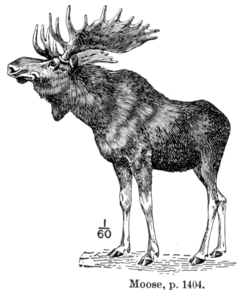Does this ever happen to you? You’re at a zoo or a wildlife park and overhear a conversation between a dad and his offspring. He is telling the child to look at the deer’s horns, or the antelope’s antlers, and it makes you ANGRY AS HELL! But you don’t say anything, because correcting a father in front of his kid would be rude, and socially taboo, no matter how disgustingly wrong his information is. This happens to me with startling frequency. Seriously, the things people don’t know about animals astounds me. So, let me explain the difference between horns and antlers in the hopes that NO ONE WILL GET THEM MIXED UP AGAIN!
Antlers: Guess what? Deer have antlers (except for musk deer, they have tusk/fang things). In most species, only the male have antlers, which they shed after the fall rut (female caribou have small antlers). Unlike horns, antlers are branched, and each new set gets bigger as the animal ages. Want to know something else? Moose are technically deer.


Horns: Animals in the bovidae (think cattle, sheep, and antelope) have horns, as do giraffe and rhinos. Horns are made up of keratin and cover a core of bone (rhino horns are the exception as they do not have a bone core). As a general rule, horns do not branch, and they are more common in males (although females also have them in certain species). Unlike antlers, horns are not shed, so if they break, that sucks. Only in some species do horns continuously grow with age.
Pronghorns: This is where it gets complicated. Pronghorns are only found on…you guessed it, pronghorns. These North American mammals are not technically antelope, as they are commonly labeled. They are the last surviving members of the family, Antilocaprida. Pronghorn “horns” are made of keratin sheathes that grow over a bone core, much as they do in true antelope. The horns of a pronghorn, however, are pronged (duh) and are shed annually. Both male and female have them, although the horns of the males’ are more pronounced.
So, now that we know the differences between horns and antlers and pronghorns, we will never get them confused EVER AGAIN! Right? Good.



Brain Master, you have done it again. I learned things! You should feel accomplished. Though antelope's antlers does have some nice alliteration to it...
ReplyDeleteIn sweden we dont have to make this distinction. Horns VS Horns VS Horns!
ReplyDeleteLess words, Less Know it alls.....
Honestly there's a species I'm making for a comic series, that have horn like growths on their forehead approximately 2/5ths the way up the arch backwards slightly, and they shed every once in a while, what classification would they have, horns antlers or pronghorns
ReplyDeleteThey range from 10 inches in overall height, to about 3 feet
ReplyDelete